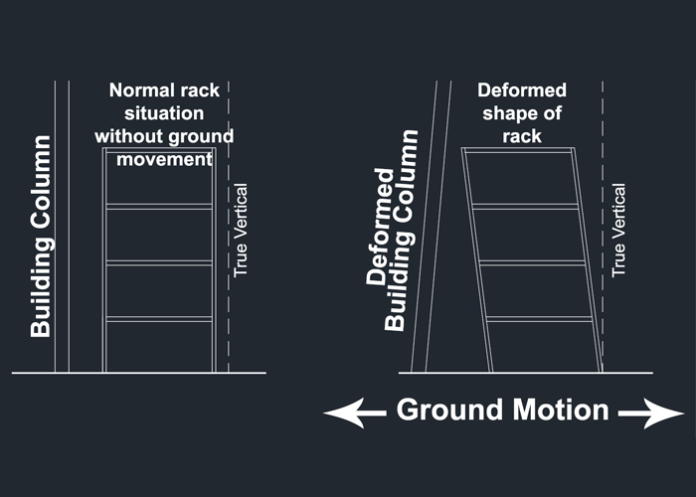In the last five years, seismic separation in racking layouts has become increasingly enforced and a section on seismic separation has been written into the 2012 RMI specification. Seismic separation is the required horizontal distance between the building columns or walls and the racking components. To compute the seismic separation requirement for a rack project in an elevated seismic risk area, the seismic displacements of the rack and the building need to be known or calculated. Once these values are determined, the required seismic separation can be computed. These separation distances will be different for the down-aisle and the cross-aisle direction of the rack and may have more impact on warehouse design in areas with higher ground accelerations.
The required seismic separation will usually be greater than a typical rack layout would allow for a distance from the building walls or columns to the rack. Most engineers allow as much aisle space possible to help forklifts maneuver the warehouse. In higher seismic areas, the building officials may require that the layout be changed so the required separation distances can be established. This can have a significant effect on the rack layout and may cause problems when the rack user has to increase flue space and reduce forklift aisles. Back spacers may also fall too close to frame lines in the down-aisle direction and have to be re-sized or adjusted. A typical proposed layout may only have 2-3 inches between the building column and the rear pallet rack beam but when the seismic separation is computed, it can be up to 12 inches or more. The warehouse layout can be drastically different from the original design once these values are considered and pallet placement locations are usually impacted.
What is the purpose of these requirements?
The purpose is to avoid the collision between the rack structure and the building structure in the event of an earthquake. Because the rack and the building will both move independently during the earthquake, both must be considered in the calculation.
What should be done initially?
The rack user should be warned about this potential issue and that the requirement may cause the layout to be altered once the final design is complete and the separation requirements are determined. The building owner will need to try to find out what the seismic drift of the building is in each direction. If this value is not available, there are default values in the RMI Specification that can be applied. The rack engineer will calculate the amplified seismic drift of the rack in the cross-aisle and the down-aisle directions. The racking layout will then be adjusted to include the new values of separation.
In the end, bay configurations will need to accommodate the movement of the pallet rack and the building during an earthquake, so working seismic separation into the equation as early as possible may stop the headaches of a complete layout change before the project is too far along.
